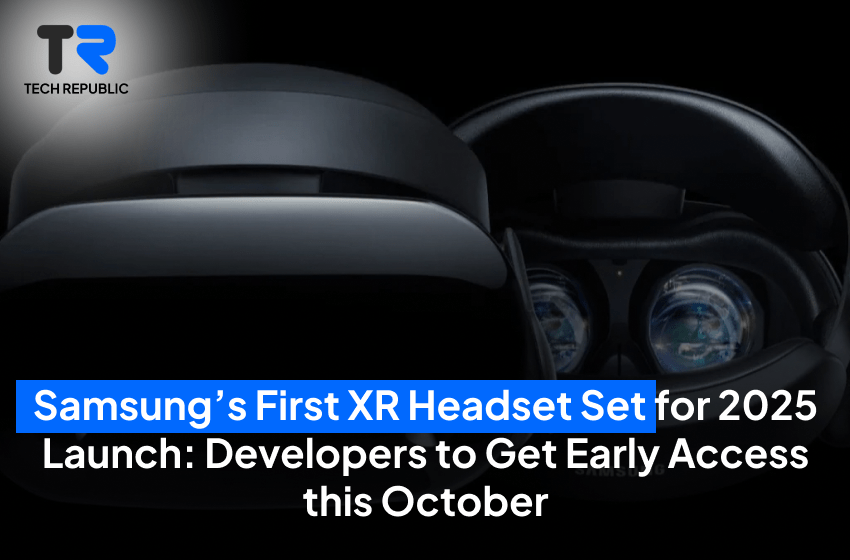
TECH REPUBLIC
PREMIUM PRODUCTS, AFFORDABALE PRICES
PREMIUM PRODUCTS, AFFORDABALE PRICES

In a significant step forward for immersive technology, Samsung is set to launch its first extended reality (XR) headset in 2025, marking the tech giant’s entry into the highly competitive field of augmented, virtual, and mixed reality. This headset is anticipated to bring Samsung’s renowned innovation into a domain dominated by industry leaders like Meta, Apple, and Microsoft. Excitingly, developers may get their hands on this cutting-edge device as early as October 2024, signaling Samsung’s commitment to fostering a robust ecosystem for content and applications before the public launch.
What to Expect from Samsung’s XR Headset
Samsung has a history of advancing mobile and wearable technology, and its XR headset is expected to be no exception. Here’s a sneak peek at the rumored features and capabilities of this game-changing device:
1. Immersive Display Quality
Known for its high-resolution displays in smartphones and tablets, Samsung is likely to bring similar excellence to the XR headset. Industry insiders speculate that it will feature an OLED display, enhancing brightness, contrast, and color accuracy—qualities that are essential for creating an immersive experience.
2. Lightweight Design and Ergonomics
Comfort is a significant factor in prolonged XR use, and Samsung seems set to deliver with a sleek and lightweight headset. Leveraging their expertise in materials and wearable technology, Samsung may incorporate a balanced, ergonomic design, reducing strain on the neck and eyes.
3. Powerful Processing Capabilities
Samsung’s XR headset is rumored to be powered by a next-gen processor developed in collaboration with Qualcomm, promising impressive graphics and processing power. This will enable users to experience complex simulations, gaming environments, and productivity applications without lag.
4. Multi-Platform Compatibility
Samsung has long advocated for interconnected devices within its ecosystem, and this headset will likely continue that trend. Users may expect seamless compatibility with Samsung smartphones, tablets, and smart TVs. Samsung’s XR headset may also support integration with other devices, potentially catering to both Android and PC users.
5. Advanced Tracking and Gesture Control
The headset is expected to feature state-of-the-art sensors for hand tracking, eye-tracking, and potentially even gesture control, allowing users to interact intuitively with virtual elements. This would be particularly beneficial for gaming, training, and enterprise applications, where precision is key.
Developer Access and the Early SDK
Samsung’s decision to provide early access to developers demonstrates its intent to establish a wide array of apps and content available at launch. This October, Samsung is expected to release a Software Development Kit (SDK) for the device. Here’s why this early access matters:
1. Building a Rich Content Ecosystem
By allowing developers to experiment with the XR headset months before its official release, Samsung is creating an opportunity for them to craft unique applications tailored to its specific capabilities. This approach ensures that when the headset hits the market, users can immediately dive into an ecosystem of optimized, high-quality content.
2. Feedback Loop for Iterative Improvement
Developer feedback on the hardware and SDK will be invaluable as Samsung refines its product. In turn, developers can gain insight into optimizing their applications and designing user interfaces that align with the device’s strengths.
3. Opportunities in Diverse Sectors
Samsung’s XR ambitions extend beyond gaming and entertainment. With early access, developers across healthcare, education, retail, and corporate training can develop applications that bring new experiences and solutions to these fields. For instance, surgeons could simulate procedures, educators could offer interactive lessons, and retailers could create virtual shopping experiences.
Competing with the Big Players: Samsung’s Strategic Timing
Samsung’s XR debut will put it head-to-head with competitors like Meta’s Quest line and Apple’s Vision Pro. The decision to launch in 2025—after competitors have set their standards—could be strategic. Samsung has had the chance to learn from early adopters and market reactions, giving it the insight needed to enter the market with a mature, refined product that meets or exceeds current standards.
Samsung’s XR headset represents more than just a product launch; it’s a bold step into the immersive technology landscape. With early developer access beginning this October, Samsung is positioning itself as a major player in XR, and its commitment to fostering an ecosystem around the headset suggests a long-term vision for growth and innovation. Developers and users alike have a lot to look forward to, with expectations running high for what Samsung’s entry will bring to the world of XR.






WhatsApp us
Exchange:
You can exchange any product purchased from Techrepublic.pk within 7 days of purchase under the following conditions:
To raise a dispute, please notify us within 7 days of delivery by contacting our support team via email at hello@techrepublic.pk or by calling 0332 272 2666. Each dispute will be evaluated on a case-by-case basis, and we strive to find a fair resolution for both parties.
For damaged items, it is essential to provide an unboxing video as evidence. Please email the video to hello@techrepublic.pk within 7 days of purchase to initiate the replacement process.
Returns:
If a product received does not match the description on our website, you have 7 working days from the date of delivery to claim an exchange the order. To initiate a return, the product(s) must be undamaged, unopened, and returned with all packaging materials and documentation.